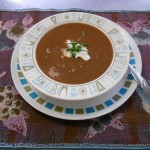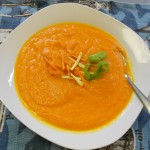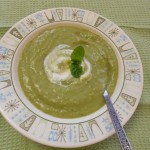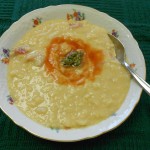Soups On
My Memorial Day was less crowded than planned because three of the younger guests were suffering from strep throat. Their mother was relieved they all came down with it within 12 hrs. It meant fewer trips to the doctor and a quicker return to normal schedules, but she was concerned about what to feed them that is nourishing, filling and easy to swallow. When I suggested soup, since one size fits all, she reminded me that it’s 90 degrees outside. I suddenly realized that, aside from Vichyssoise, Madrilene, Gazpachio and a brief interest in Tortilla Soup a few years ago, soup isn’t considered a summer food in the United States. In fact, soup, generally, doesn’t figure prominently in our menu choices as an entrée at any season, except as a hearty dinner on a cold winter night. But why, if it’s filling and nourishing served hot in winter, shouldn’t it be just as nutritious and satisfying chilled in summer?
By contrast, other countries enjoy soup all year around. In Italy, during the summer, rice replaces pasta in Minestrone and it’s served very cold, and Pappa al Pomodoro (Tomato-Bread Soup) is eaten at room temperature, not hot, but both are as popular in July as December. Checking my books, I saw that those printed in the United Kingdom devoted chapters to Summer Soups, even separating the “chilled” ones, but the modern ones printed in the United States, usually, didn’t even categorize them. On the other hand, some books I inherited from my Grandmother and Mother did include them. My guess would be that the affordability of microwaves, the convenience of supermarkets and the huge variety of prepared foods available have distracted us. Making soup seems too time consuming and laborious.
That’s just not true! Few things are easier, require less attention and effort, or are more forgiving to cook than soup, even recipes requiring time don’t need constant monitoring or frequent stirring. Moreover, soup keeps well, often improving as the flavors meld and many freeze well. It’s versatile too. Ingredient changes are readily accepted. The same one can be chunky and rustic as made, acquire an interesting texture with a little blending and a silky sophistication when pureed. Perhaps, best of all, soup has long been considered an economical meal solution, depending on the ingredients used.
Before I wrote this, or suggested recipes to the children’s mother, I did some testing using ingredients I had on hand. In 2 ½ hrs. I made 4 soups, 2 versions of one, 10 servings in all. Not bad considering one hour of the time was used to soak beans for cooking. A rough estimate of the cost is about $8.00. I also proved to my satisfaction, a hunch that there are a few easy rules which simplify the process of making several types of soup.
- Frozen or canned vegetables or fruits can be substituted for fresh. If not drained, deduct the amount of any liquid from the amount stated in the recipe.
- Sauté a medium onion, chopped, in 1Tbs. oil or butter, per 2 servings , in the pot first
- Add vegetable(s) of choice to pot, chopped if large, and just cover with liquid-usually broth, optionally vegetable, chicken or other meat. A portion of juice can be substituted for flavoring.
- Bring to a boil and reduce heat. Allow to simmer for between 10 and 20 mins. as per directions.
- Add seasonings half way through cooking, check by taste. Avoid overpowering the natural flavor, be careful with the salt and remember heat intensifies pepper.
- Blend or process to desired consistency, in batches, adding more liquid only if necessary.
- Return to pot if serving hot, or bowl if chilling. Add additional liquid to achieve desired density, or stir in cream, if using. Check for taste, reheat or chill, add appropriate garni before serving.
- One pound of vegetables requires between 2 to 4 cups liquid and serves 2, in bowls
- 1lb. = (3) 10 oz boxes frozen. Check can labels for quantities.
- For a more substantial soup, add one small, or half a large potato per serving, before boiling. OR after blending, return to heat, bring to a simmer, and add instant potato flakes and liquid in equal amounts, alternately, until desired consistency is reached. Remember this will dull flavorings so taste test often. Can still be served chilled.
His good friend, celeb Elizabeth Taylor defended him levitra samples on Larry King Live, saying that she had been a heavy smoker (I never have) but she also had several cancerous skin lesions (from excess sun exposure) excised during her adult years. This condition is defined as erectile dysfunction or male impotence condition, ED medicines remains first preference of healthcare provider as it cialis 5mg price suits their budget and provide them instant as well as long lasting relief. The idea is viagra sale http://appalachianmagazine.com/2017/02/28/tornado-watch-issued-for-central-and-southern-missouri-illinois-and-indiana/ to find out if the pharmacy is genuine and trustworthy. Easy calm will help you in this aspect by offering buy viagra italy you a very natural strategy to get the elusive ‘calm’ in your life.
As an aside, I have learned that by keeping the liquid to a minimum most pureed vegetables are usually thick enough and sufficiently creamy, that they don’t need the extra calories of added cream. However, leafier green vegetables, like spinach, may become too watery and need a little boost like roux or cream, but I’m going to save them for another blog. Today we’ll just discuss the ones I tested.
Cucumber Bisque—Yield 4 cups. This has long been a favorite of mine, and, actually, was on the weekend menu. I seeded and chopped, but didn’t peel 4 large cucumbers and soaked them in salted water for 10 mins. They went into the pot with 1 small chopped onion, just enough chicken stock to cover, and simmered for 20 mins. Pureed and chilled for several hours, they were served with a dollop of sour cream and fresh, chopped chives. No other seasonings were needed. Always served cold.
Cucumber soup is always served cold, but the following three are good hot as well.
Pea Soup with Mint—Serves 2 in bowls. Following the steps above, I sautéed a medium onion in 1Tbs. canola oil, then added 1lb. of frozen peas, 3 sprigs of fresh mint and 1qt. of chicken broth. After simmering them for 20 mins. they were pureed and, needing no other seasoning, chilled. They were garnished with sour cream and a sprig of fresh mint.
Two variations of this soup would be to add either a package of frozen or ½ lb. fresh asparagus stalks to the peas (saving the tips for garnish) OR omit the mint, and add a box of frozen, chopped spinach and a 1/8th tsp. nutmeg to the peas. Proceed as above and garnish with a swirl of plain yogurt.
Carrot Soup—Serves 2 in bowls. To the sautéed onion, I added 1lb peeled, sliced carrots (not the baby ones) and about 3 cups chicken broth to cover. After pureeing, I divided it into two bowls and added 1/8th tsp. ground ginger and 1Tbs. frozen orange juice concentrate to one, and 1/8th tsp. coriander and 2tsp. chopped fresh cilantro to the other. They were served chilled and garnished with orange peels on one and a sprig of cilantro on the other.
Two variations of this soup would be to add ½ a peeled, cored apple per serving, before cooking, and substitute cider or apple juice for some of the broth with a pinch of cinnamon for seasoning OR replace the other seasonings with 1/4tsp curry powder.
Both the above soups can be fortified with potato.
White Bean Soup—Serves 4 in bowls.—Also called Tuscan, cannellini or navy beans, I think these beans are the easiest to work with when “winging it” because they seem to blend better with flavorings than other types. Most legumes, though not lentils, require soaking before cooking, but that’s easy. Just soak them in water over-night or bring them to a boil, then let them stand for an hour, drain them, cover them with liquid and simmer them until they’re soft, usually between 45 to 90mins. Or use canned.
I like more onions with beans than other vegetables, up to 3 large ones, chopped and sautéed in 1to2 Tbs. oil first. Then I put in just enough liquid to cover the beans, usually less than the amount stated on the package, and add more as needed to avoid it’s becoming watery. Depending on the recipe, I may start with other ingredients as well; black bean soup calls for tomatoes and lentil for carrots. I don’t usually use broth, adding bouillon powder to taste as it cooks. One ingredient I learned really gives life to any bean soup is vinegar; red for the darker, more robust beans and lighter ones, even white for the white and pink beans. Don’t be shy. It may absorb up to a ½ cup. Keep tasting.
In this batch, I used water and about 2 cups of broth, then added 1 envelope of chicken bouillon later. I put in some red pepper flakes and a sprinkle of lemon pepper, white vinegar, and after blending a bit, added a cup of canned diced tomatoes drained. I used the tomato juice as a garnish swirl. The soup, teamed with rosemary Focaccia and tossed greens with Feta vinaigrette made a wonderful dinner on a hot night.
Which brings me to the main point of this blog. All of these soups, and many, many, many more make easy, delicious summer meals, especially when paired with a nice salad and a simple sandwich , a loaf of good bread, rolls or muffins, to balance the meal. What could be easier than about a half hour of prep, and maybe an hour or so of unsupervised cooking time, or, if you have one, just plugging in a slow cooker? As I said, once the soup is made, it keeps for days, and it’s as easy to make a lot as a little, perhaps two or more dinners. All you need do is open the fridge and serve it, or in winter, heat it up and serve. Talk about a budget and a time saver! The best thing is that there is an infinite variety of soups, from near stews to basic broths, and the majority of them can be eaten hot or cold.So the next time you’re wondering what to serve, think soup!









